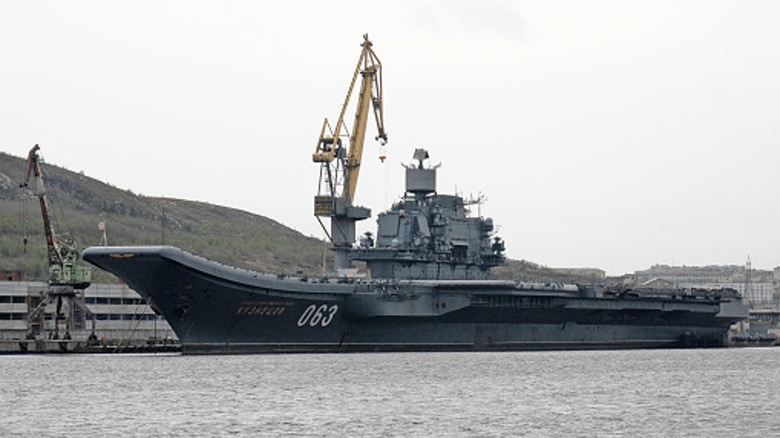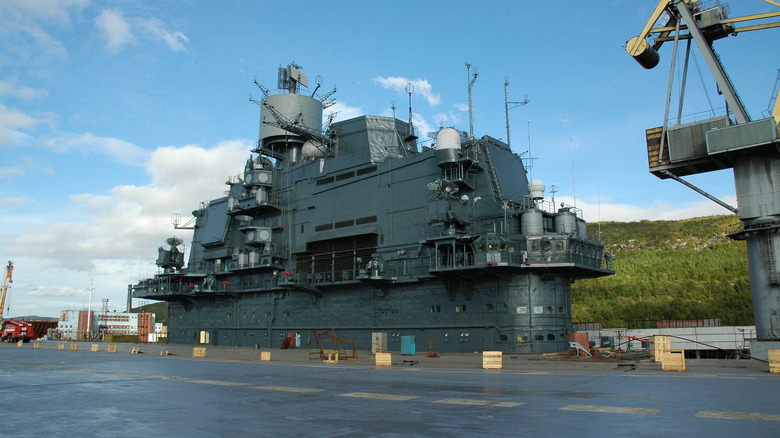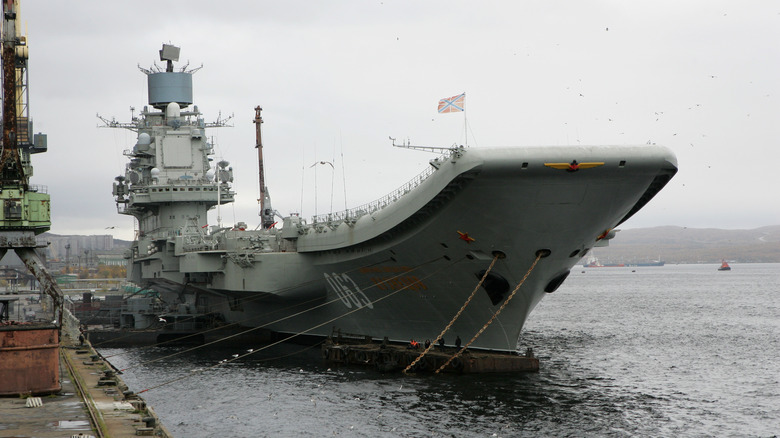How Many Aircraft Carriers Does Russia Have? One, And Here's Why
Unlike the United States Navy, which has 11 nuclear-powered aircraft carriers currently in service (not all deployed simultaneously), Russia only has one, and it's not nuclear-powered. The Kuznetsov, named after Admiral Kuznetsov has been Russia's sole flattop since 1985. However, that wasn't always the case for Russia, well, the Soviet Union. The Kuznetsov had a sister ship with a rather colorful history, but before the electrical system was installed, construction came to a halt and the Varyag was transferred to Ukraine.
It remained in the Ukraine for several years before being gutted to the point where It didn't even have a rudder. Ukraine entered negotiations with a Chinese businessman in 1998 to sell the Varyag. The buyer purchased the carrier under the pretense that he was going to transform it into a floating casino. Unbeknownst to everyone else, he was actually buying it on behalf of the Chinese government to get his country an aircraft carrier.
The Varyag arrived in China in 2002, where the government began the slow process of refitting it to become the Liaoning. This left Russia with a single aircraft carrier. The Soviet Union collapse left finances awry, and maintaining carriers wasn't possible. The newly formed government dismantled or sold them to other countries like China and India.
The cursed aircraft carrier
In 2018, Russia brought its sole aircraft carrier into port in a modernization effort. This was supposed to expand its lifespan, but it wasn't supposed to take longer than a year. Not only is the refit still ongoing six years later, but it has encountered obstacle after obstacle in drydock. Between a 70-ton crane falling onto the Kuznetsov's flight deck when it first arrived, and a fire breaking out in the engine room, three workers died and over a dozen were injured. Damage to the drydock during a power outage and the man overseeing the whole operation being arrested for embezzlement also pushed plans back further.
The Kuznetsov was no stranger to death and accidents even before it went in for repairs. A crewman died in a fire in 2009 while at sea shortly before spilling hundreds of tons of fuel overboard while refueling at sea. Tragedy seems to follow this ship wherever it goes. The ship struggles to stay in working order. Its steam turbines aren't the best quality, so a tug boat escorts the carrier in case it breaks down.
The British Defense Secretary from 2017 dubbed the Kuznetsov the "ship of shame" when it traversed the U.K. coast, spewing black smoke from its exhausts due to its fuel source known as Mazut, which is inferior to nuclear power.
The future of the Kuznetsov and Russia's navy
After all of the additional repairs required and delays, Russia has scheduled the Kuznetsov return to service by the end of 2024. However, that's only if the ship passes muster. It has several tests to complete before being deemed seaworthy again. Unfortunately, its run of bad luck has everyone on their toes and Russia is prepared to delay again until some time in 2025 if necessary.
It's an old carrier, but it's not as old as America's oldest carrier still in service, so that's not really an excuse. There were talks at one point to completely scrap the carrier as it has proven to be more work than it's worth. TASS, the Russian news agency, made a statement in 2019 that Russia was going to develop its first nuclear-powered aircraft carrier by 2023. However, the United Shipbuilding Corporation (USC) had not received any designs on such a project from Russia's Defense Ministry. Building a nuclear aircraft carrier from scratch would likely be less of a headache for Russia, as its budget has proven to be the military's biggest obstacle.
It's unknown what's going to happen to Russia's sole aircraft carrier at this point. The world will have to wait to hear the results of its tests, but it's just as possible it still won't sail. The conflict in Ukraine has also drained resources from Russia, knocking the maintenance of its only aircraft carrier further down its list of priorities.


